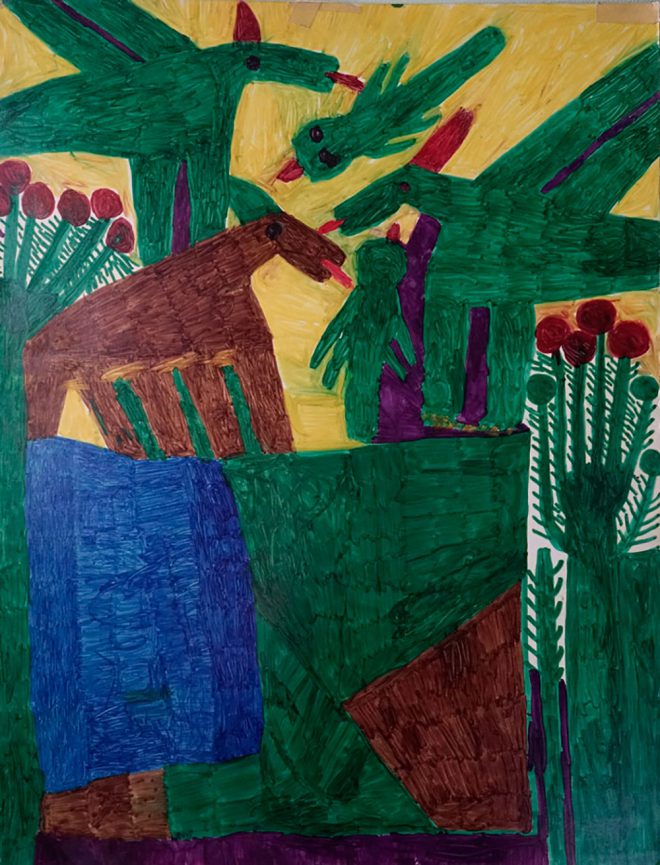Exhibition Pick: William “Willie” White at the Creative Alliance of New Orleans
Megan Koza Young looks at an exhibition that’s drawing attention to a self-taught artist who lived and worked in Central City.

William “Willie” White, Untitled, c. 1980s. Marker on poster board. Courtesy the Creative Alliance of New Orleans.
William “Willie” White
Creative Alliance of New Orleans
1307 Oretha Castle Haley Boulevard, Third Floor
April 14–June 26, 2016
This April, the Creative Alliance of New Orleans (CANO) opened “Honoring Willie White,” likely the largest exhibition of paintings and drawings by self-taught artist William “Willie” White. Showcasing forty of the artist’s works from the 1980s, this exhibition points to the longevity, richness, and depth found in the history of Louisiana’s arts, particularly those created by self-taught artists.
Born just outside Natchez, Mississippi, in 1908, White left school after the third grade to work on riverboats. He eventually settled in New Orleans, finding jobs as a janitor and as a sign painter. It was not until the 1950s that White’s interest in painting truly developed through observation of artists working in the French Quarter. His first paintings were created with house paint; however, by the ’60s, he had transitioned almost exclusively to using felt-tip markers on poster board. Although several of the Jackson Square artists befriended him and tried to offer artistic guidance, White shied away from any structured learning. From the outset, White had his own unique vision based on a blend of his imagination and his own life experiences. Eventually, White began hanging his works on a clothesline along the fence of his Dryades Street house—possibly a nod to the way street artists, even today, hang their works along the fence surrounding Jackson Square. Neighbors and friends passing by would stop to talk to him, and the drawings began to sell.
White’s bold, felt-tip marker drawings of birds, crosses, alligators, and people, all rendered with child-like simplicity and bold outlines, are filled with flat, pure color that dominates the compositions, even when situated into the framework of a landscape. For example, in one of the works in the CANO exhibition (White never titled his drawings), White created a sense of topographical depth by partitioning the poster board into an asymmetrical grid containing over 160 small squares of different sizes. Some of the grid’s modules contain crosses, ovals, and dots.
On the right-hand side of the work are three green, prehistoric-looking, bird-like creatures with red tongues, grey eyes, and black stripes along their wings. The birds are supported by triangular areas of red and thick arabesques of black as they float against the white picture plane. In this work, White has used three colors (red, black, and green) and repeated forms in groups of threes (three crosses, three ovals, three birds). Through White’s execution, his use of repetition and the guilelessness of his forms, he invokes the collective unconscious, the sacred, and a sense of ritual.
Although White was not formally trained as an artist, his work calls to mind that of the late 1940s early Abstract Expressionists like William Baziotes. Like the work of these artists, all of White’s forms are purposely flattened; any delineation of depth is articulated solely through color—bold reds, browns, blues, greens, black—and hard lines. Unlike the Modernists of the 1950s and ’60s, many of whom were trained in a European artistic tradition that relied on cultural appropriation, White’s repetitive geometric and mask-like forms are the result of his absorption and processing of images in his world outside the academy. Through this exhibition, we see the formal and emotional strength often only attributed to the trained masters discussed and exhibited in art history text books, galleries, and auction houses. “Honoring Willie White” stands as an important exhibition not only due to the breadth of works on view, but also because it reminds us of the power of so many of the South’s marginalized self-taught artists.



